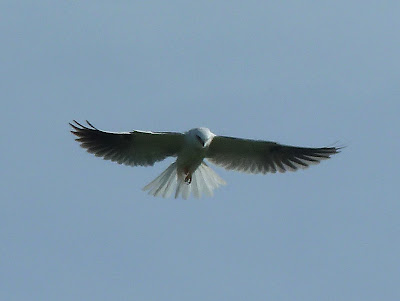The area is chained off from visitors during owl season (I believe it's roughly October to April). Signs advise viewers not to watch too long, which stresses the owls, nor to point at them, which might alert raptors. The area is riddled with ground squirrel burrows, which are just what burrowing owls like, though they are also apparently quite capable of digging their own holes.
The photo below shows the setting. It's not really what you'd expect, is it? -- although actually, according to the Cornell Lab of Ornithology, burrowing owls are notorious for showing up on golf courses, air fields, college campuses and other open grassy areas quite close to human activity. One even tried to take up residence on a cruise ship's mini-golf course a couple of years ago.
The little owl (they stand only about 8 to 9 inches high) is barely visible as a pale speck in front of a boulder close to dead center in the photo above. Can you see it? (Click on it to see it bigger.)
At the same park, we saw a beautiful white-tailed kite, which I've seen here before, perhaps the very same bird, as described as a highlight of the birds I saw in 2011:
My first white-tailed kite, seen hovering over dunes in a Berkeley, CA, bayside park in August -- a beautiful, medium-sized white hawk that at first I took to be yet another gull but whose hovering behavior caught my eye as something very different. This is a coastal bird, in the U.S. generally only to be seen along the west coast, the southern Texas gulf coast and the tip of Florida.
I wish these cropped photos were clearer, but though hovering the bird was still moving. The first time I saw it (presuming it's the same bird as in 2011, which of course it might not be), the dark tips to the wings and its raptor head helped me identify it. There is also a distinctive black spot near the bend in each wing, visible above.
The Cornell Lab describes the kite's distinctive hovering:
While hunting, the White-tailed Kite characteristically hovers up to 80 feet off the ground and then drops straight down onto prey items [almost entirely small mammals]. This ability to hold a stationary position in midair without flapping is accomplished by facing into the wind, and is so characteristic of these birds that it has come to be called kiting. White-tailed Kites also perform ritualized courtship displays in which a male offers prey to a female prior to egg laying. In an often spectacular aerial exchange, the female flies up to meet the male, turns upside-down, and grasps the prey.The word kite, which nonbirders mostly associate with the colorful toys we fly on the end of long strings, was used for the bird first; the toy very likely got its name from the way it hovers like a kite. (See, e.g., http://www.etymonline.com/index.php?term=kite.)
I came to this park in August 2011 with my son, both of us keen to see the burrowing owls we had read were to be found here. (They can be found in a few places in the western prairies of Minnesota, at the eastern edge of their range except for some outliers in Florida, but they are a state endangered species according to the Minnesota DNR.) Sadly, we learned that we were there at the wrong season; we had no chance of seeing a burrowing owl in Berkeley in August. So when I had an opportunity to go again last week, I had to see if I could finally see my lifer burrowing owl. I hope my son gets to see his before too long.





2 comments:
Two amazing birds in one post! Wonderful! I love the burrowing owl's scowl. If "kite" the toy comes from "kite" the bird, does "scowl" derive from "owl??
Two years ago (this month), we stayed at the Doubletree Inn at the Berkeley Marina, which is right next to this park. The park is a great place for walking next to the bay, and the owls are charming.
Post a Comment